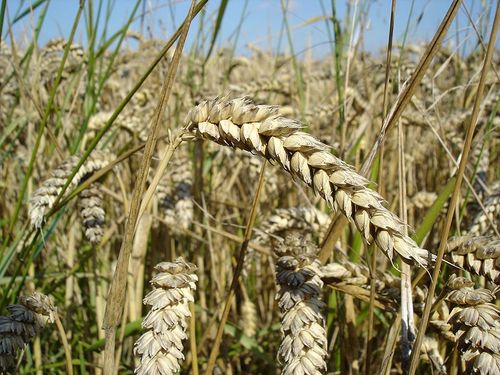I’m going to give you guys a breakdown of gluten, grains, and pseudograins.
I don’t want you to be afraid of grains (unless you’ve got celiac disease or a diagnosed non-celiac gluten intolerance). As many as 1 person in 8 could gluten intolerant. That means that 7 people in 8 are not gluten intolerant.
So, instead of telling you that you’re going to die if you have grains more than once every 90 days, I’m going to give you a scale of which grains have the most to least gluten, and show you how to move down the scale.
Josh’s Gluten Countdown:
10.) Bleached Modern Common Wheat
- Modern Era
- High Gluten Content
- Genetically Modified
- Bleached
- 3 pairs of wheat chromosomes (Hexaploid)
9.) Whole Grain Modern Common Wheat
- Modern Era
- High Gluten Content
- Genetically Modified
- Higher Fiber Content
- 3 pairs of wheat chromosomes (Hexaploid)
8.) Spelt Wheat
- Bronze Age
- High Gluten Content
- 3 pairs of wheat chromosomes (Hexaploid)
7.) Durum Wheat
- Bronze Age to Modern (pasta)
- High Gluten Content
- 2 pairs of wheat chromosomes (Tetraploid)
6.) Emmer Wheat
- Bronze Age
- High Gluten Content
- 2 pairs of wheat chromosomes (Tetraploid)
5.) Einkorn Wheat
- Epi-Paleolithic Era
- Very low Gluten Content
- 1 pair of wheat chromosome (Diploid)
4.) Oats
- Bronze Age
- Gluten Free (unless contaminated at processing)
- Saponin Free
3.) Amaranth
- Epi-Paleolithic Era
- Gluten Free
- Low Saponin Content
2.) Brown Rice
- Neolithic Era
- Gluten Free
- Saponin Free
1.) Quinoa
- Neolithic Era
- Gluten Free
- Saponin Free (the saponin peel is removed in milling).
What Does it All Mean?
When?
First thing on each grain/pseudograin, I list when it’s from. The thinking in groups that are Paleo/Ancient Foods tends to be that if it’s older, it’s better. Case in point – there have been a couple studies now showing that Einkorn wheat (which was first harvested wild in the Epi-Paleolithic Era) doesn’t cause the same gluten inflammation that modern wheat does.
Gluten?
Second thing is if it has gluten. The first five things I list a true grains – they are types of wheat – and they all have gluten. The second five are “pseudo-grains” – they aren’t wheat, and they have no gluten.
How Many Wheat Chromosomes?
For the grains, I list whether they have 3 pairs of wheat chromosomes, 2 pairs of wheat chromosomes, or 1 pair of wheat chromosomes. This is an indication of how many times it was cross-bred with other wheat. In cross breading, they actually intended to *increase* gluten content, because it makes for wheat that’s easier to harvest and easier to mill.
There is some evidence that wheat with fewer pairs of chromosomes is less inflammatory. That a 2 pair of chromosome wheat like einkorn might be better for people who have a legitimate gluten sensitivity (though not celiac disease).
That being said, keep in mind that there is a fair amount of controversy around if non-celiac gluten sensitivity actually exists and what it is. If you think you have a non-celiac gluten sensitivity, to work with a medical doctor and eliminate celiac disease and wheat allergy first.
Finally, there have been some findings that the symptoms people are getting from wheat products may not have to do with gluten, but that there is something else at the root of what we’ve been calling non-celiac gluten sensitivity.
GMO at all?
These days, they don’t need to cross-breed wheat, they can just genetically modify it.
Saponin
Saponins are considered an “anti-nutrient” by the Paleo community.
Oddly, they’re also being looked at for their health benefits. Saponins are also found in vegetables like peas and alfalfa.
An old Paleo knock against quinoa was that it grows with a saponin cover in the wild. But that doesn’t really matter, because it’s shell is always milled off before being sent to North America. In fact, the quinoa we buy in the United States has had 99.9997% of the saponin milled away.
So, the jury is probably still out on if these are bad or are superfoods (!), but you don’t need to worry about your brown rice or quinoa having any.
Don’t Be Afraid
First, you should be less scared of food. I hate how many Paleo authors use full on scare tactics. Hell, I even get scared reading some Paleo authors ranting.
There is A LOT that I love about Paleo – it’s high protein, has good healthy fats, lots of veggies and fruit.
The only thing I don’t like is the premise that everything else will kill you. You should know that there are pseudo-grains like quinoa and brown rice that are perfectly safe. And all of the fitness competitors, bikini competitors I ever run into get their carbs from brown rice, oats and quinoa. I always ask.
So What You Should Do is Experiment:
Where ever you are on the countdown, try moving down a step or two. See if it changes how you feel, see if it makes a difference in your fat loss.
If you’re currently eating strict Paleo, try out adding quinoa or brown rice once in a while. See if it agrees with you or not. You just might feel just as awesome as ever – and if you do – it opens up a whole new world of food variation.
Who knows, maybe even try out einkorn! You might love einkorn and feel great with that. That really opens things up.
If you’re cool with einkorn, who knows, you could get really crazy and experiment with emmer! Maybe even spelt!
The alternate side of people thinking that gluten causes inflammation… is that we have large meta-analyses showing that whole grains reduce inflammation.
Experiment and enjoy!
By Josh Hillis, RKC, CPT, PES, ZMIS
Author of:
The Stubborn Seven Pounds
System Six: The Absolute Minimum Workout
The 21 Day Kettlebell Swing Challenge
Josh has been featured in:
USA Today
The Denver Post
The Los Angeles Times
Josh is a co-author of DragonDoor Publishing’s
The RKC Book of Strength and Conditioning


Leave a Reply